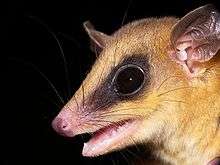Marmosa
| Mouse opossums | |
|---|---|
 | |
| Robinson's mouse opossum (Marmosa robinsoni). | |
| Scientific classification | |
| Kingdom: | Animalia |
| Phylum: | Chordata |
| Class: | Mammalia |
| Infraclass: | Marsupialia |
| Order: | Didelphimorphia |
| Family: | Didelphidae |
| Subfamily: | Didelphinae |
| Genus: | Marmosa Gray, 1821 |
| Type species | |
| Didelphis marina Gray, 1821 | |
| Subgenera | |
| |
The nineteen species in the genus Marmosa are relatively small Neotropic members of the family Didelphidae.[1] This genus is one of three that are known as mouse opossums. The others are Thylamys (the "fat-tailed mouse opossums") and Tlacuatzin, the grayish mouse opossum. Members of the genus Marmosops used to be called "slender mouse opossums", but are now just called "slender opossums". The six members of the Marmosa subgenus Micoureus, known as "woolly mouse opossums", were formerly considered to be a separate genus,[2] but were moved into Marmosa in 2009.[3][4] Based on a comparison of sequences of one mitochondrial and three nuclear genes, three new subgenera, Eomarmosa, Exulomarmosa and Stegomarmosa, were recognized by Voss et al. in 2014.[4] Eomarmosa and Exulomarmosa, as well as Marmosa and Micoureus, are thought to be sister taxa, while Stegomarmosa is viewed as sister to Marmosa plus Micoureus. Exulomarmosa is a mostly trans-Andean (west of the Andes) clade.[4]
Subgenus Eomarmosa (Voss et al., 2014):
Subgenus Exulomarmosa (Voss et al., 2014):
- Marmosa isthmica
- Marmosa mexicana
- Marmosa robinsoni
- Marmosa simonsi
- Marmosa xerophila
- Marmosa zeledoni
Subgenus Marmosa (Gray, 1821):
- Marmosa macrotarsus
- Marmosa murina
- Marmosa tyleriana
- Marmosa waterhousei
Subgenus Micoureus (Lesson, 1842):
- Marmosa alstoni
- Marmosa constantiae
- Marmosa demerarae
- Marmosa paraguayana
- Marmosa phaea
- Marmosa regina
Subgenus Stegomarmosa (Pine, 1972):
References
- ↑ Gutiérrez, EE; Jansa, SA; Voss, RS (2010). "Molecular systematics of mouse opossums (Didelphidae: Marmosa): assessing species limits using mitochondrial DNA sequences, with comments on phylogenetic relationships and biogeography". American Museum Novitates. 3692: 1–22. doi:10.1206/708.1.
- ↑ Gardner, A.L. (2005). "Order Didelphimorphia". In Wilson, D.E.; Reeder, D.M. Mammal Species of the World: A Taxonomic and Geographic Reference (3rd ed.). Johns Hopkins University Press. pp. 3–18. ISBN 978-0-8018-8221-0. OCLC 62265494.
- ↑ Voss, R. S.; Jansa, S. A. (2009). "Phylogenetic relationships and classification of didelphid marsupials, an extant radiation of New World metatherian mammals". Bulletin of the American Museum of Natural History. 322: 1–177. doi:10.1206/322.1. Retrieved 2012-01-18.
- 1 2 3 Voss, Robert S; Gutiérrez, Eliécer E; Solari, Sergio; Rossi, Rogerio V; Jansa, Sharon A (2014). "Phylogenetic relationships of mouse opossums (Didelphidae, Marmosa) with a revised subgeneric classification and notes on sympatric diversity". American Museum Novitates. 3817: 1–27. doi:10.1206/3817.1.